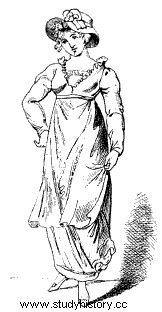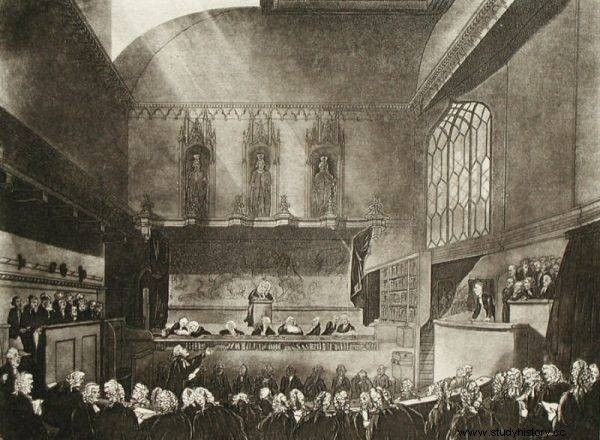History repeats itself - this is a cliche that everyone has heard. After all, the past is filled with similar events. Political conflicts, tactical mistakes, decisions that evoke events from more or less distant times. These are usually generalities that resemble other similar circumstances. However, it gets interesting when the events taking place almost two centuries after each other start to combine small, seemingly insignificant details. This is how urban legends are born ...
Mary Ashford - a crime born of lust
Mary Ashford was a 20-year-old maid working as a servant on her uncle's farm near Erdington, Warwickshire. Young, attractive and sociable - these words could describe a girl. In addition to helping on the farm, she also dealt with small trades, selling dairy products at local markets. She was widely known and liked in the neighborhood.
On Whit Sunday, May 27, 1817, Mary and her friend Hannah Cox went to a party at The Three Tuns in Erdington. They spent a great evening in the company of two young men, with whom they later left the party together and went for a walk . After some time, the couples broke up. Adorer Hannah escorted her home, and Mary, with Abraham Thornton, continued for a walk to a more secluded place. Around four in the morning, the girl returned to her friend's house to change clothes and go to work on the farm. Unfortunately, she never made it. When morning came, her body was discovered by a traveling worker.

Mary Ashford
Sexually abused and then drowned - this was the opinion given by the people who carried out the autopsy. On that tragic night, the girl was to lose both her life and virginity, as evidenced, among others, by blood stains on her body and clothes . A footprint was also found at the crime scene. Both of these pieces of evidence contributed to the charges against Abraham, with whom Mary missed the game.
The man was considered a man of good manners by the locals, but he was not well-liked. Lots of people said there was something off-putting about it. Witnesses were said to have testified that Thornton made strange comments about "getting her at all costs" during a play which resulted in Mary's death. These words, along with the blood stains on his underwear and the imprint of the sole, tied him directly to the crime. The man was arrested immediately. In court, Thornton defended himself, arguing that there had been a rapprochement between him and Mary, but that it was by mutual consent. Later, he took the girl to his friend's house and saw no more. By court decision, Abraham was acquitted, based on a lack of strong evidence.
God's judgment
The local community, as well as the brother of the murdered, could not come to terms with this sentence. William Ashford appealed, but this time Thornton stepped forward and requested a court match. It was one of the forms of ordinations, or divine judgments, a practice dating back to the Middle Ages to decide on guilt or not, and by oversight, still present in British law.
William did not like this turn of events. In his opinion, the evidence clearly pointed to Abraham's guilt, making the case ineligible for a fight . The court, however, was of a different opinion. In his opinion, the evidence was not obvious and he agreed to the duel. If Ashford wins, his opponent will be immediately convicted and executed, but if he loses Thornton will be exonerated once and for all.

Image of the Royal Court
Mary's brother declined the offer, which contributed to the final cleansing of Abraham's name. Interestingly, this case led to the abolition of the right to a duel due to dissatisfaction of the public opinion convinced of Thornton's guilt. And although the man was acquitted, the publicity brought to him by the trial forced him to emigrate to the USA . This is where the story might end and be covered with dust, if not for the events that happened 157 years later.
Barbara Forest - history repeats itself?
Barbara Forest was a 20-year-old young lady working in a nursing home outside Erdington, Warwickshire. Young, attractive and sociable - these words could describe a girl. She was widely known and liked in the area. On Pentecost, May 27, 1974, Barbara and her boyfriend Simon went out to town. They spent a nice evening together, having fun in local pubs, and then they parted at the bus stop, from where the girl was supposed to return home. Unfortunately, it never got through to him.

Local newspapers reported the crime
Her half-naked body was discovered days later. She was raped and then strangled. Clues and testimonies from witnesses led investigators to Michael Thornton, whom Barbara knew from working in a children's care center. The man was arrested on the basis of blood stains found on his pants and a false alibi submitted by his mother . The lack of strong evidence and this time contributed to not solving the mystery of the girl's death.
As DNA testing became more popular, Barbara's sister demanded that the case be reopened and the evidence examined. Unfortunately, the answer was not clear this time as well. To this day, the real killer of Forest is unknown.
Chilling coincidences
The Barbara Forest murder case brought back from the depths of history the unsolved murder of Mary Ashford. It turned out that both crimes have terrifyingly many details. The bodies of the women were found in places no more than 300 meters apart. They were both 20 years old and were killed after an evening of partying at Pentecost. Interestingly, although it is a movable holiday, in the years when they were murdered, it fell on the exact same day - May 27 . Suspects in both cases were acquitted and, moreover, both bore the same surname - Thornton.

Pype Hayes Park, this is where the bodies of both women were discovered
7 days before her death, Mary confided to a friend that she "had a bad feeling about the coming week." And 10 days before the murder, Barbara was supposed to tell her friend:“This will be my unhappy month. Don't ask why. " And while most of the theories about these events can be safely put on the shelf with stories by the camp fire, the saying "history likes to repeat itself" on this issue can make your spine shiver.
